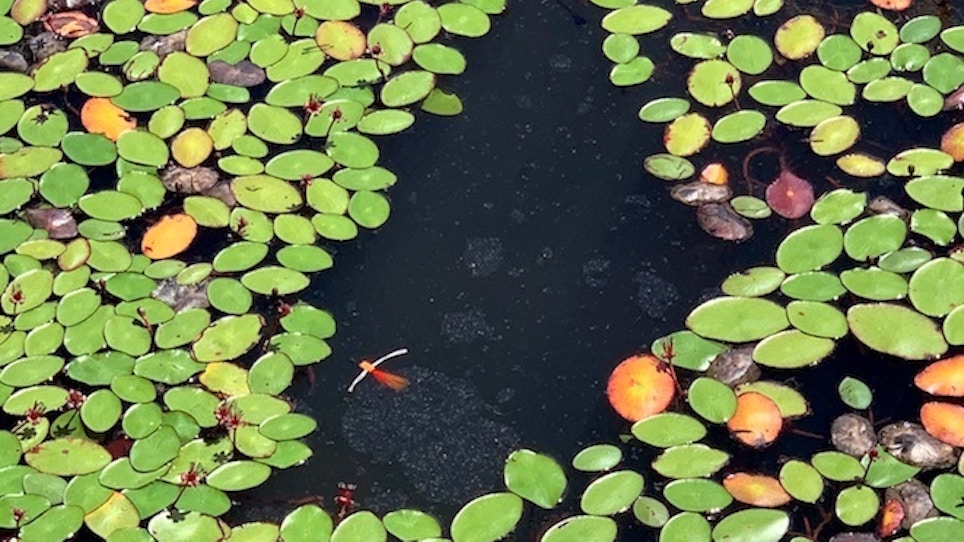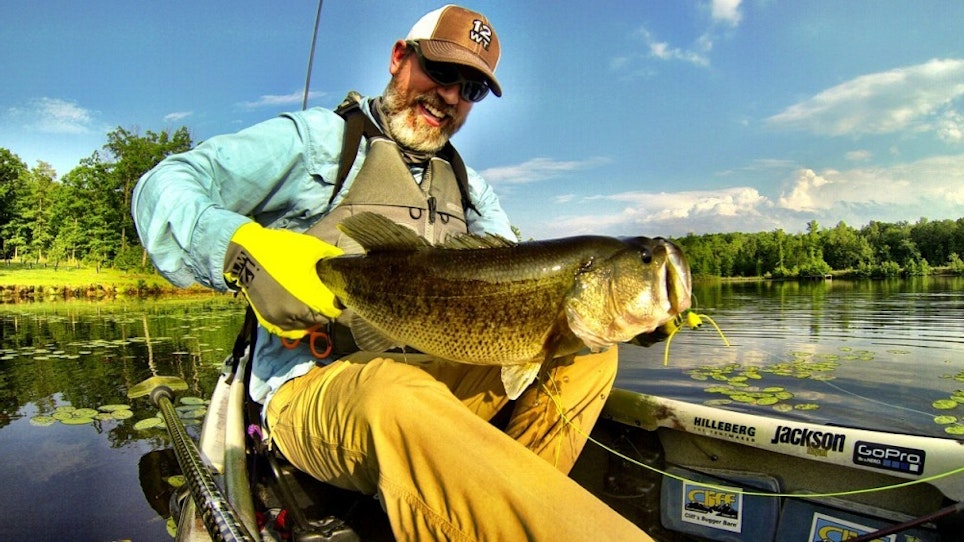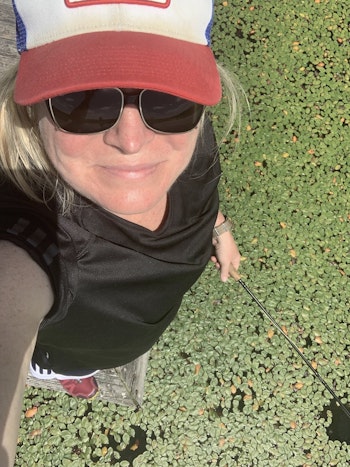
Creep close to lily mats or thick stretches of watershield, the vegetation that's pictured here, to drop poppers into openings and avoid the need to be super accurate with your fly casts. Photo: Amy Hatfield
There’s a 6-acre pond on our property that’s used primarily for irrigating peach orchards. When my family bought the place, the pond was used solely for fishing, and there was little vegetation on the water. But as the pond levels rescinded in the summer months when irrigation was frequent, and then those seasons were coupled with a few dry winters, we ended up with quite a crop of lily pads.
Or at least that’s what I called the vegetation. But the leaves are small, so I've learned that, technically, what we have is watershield. And I hated it. It's beneficial to wildlife. The waterfowl love it and it's great cover for fish. But it's taken so many of my son's nightcrawlers, and plenty of traditional bass lures and flies. Quickly, we adapted and went with weedless lures. But still, often the watershield won.

Before the vegetation takeover, I had never fished a pond or lake with cover. My experiences were limited to clean ponds, the occasional salt water expedition and North Carolina’s trout streams. But managing or ridding the pond of the watershield promised to be costly, and I soon realized I was an idiot not to embrace this stuff. Like lily pads and other shielding vegetation, it often marks where the fish are, particularly the big ones.
So to figure out how to make the most of what’s actually a good situation, I turned to fellow South Carolina native and Jackson Kayak Product Manager Damon Bungard. Because I like to fly fish for bass and my 7-year-old son is just getting into bass fishing with traditional tackle, I wanted to learn how to approach the lily pads and other top-water vegetation with both flies and bass lures.
This article is focused on fly fishing bass, while Part 2 dials into fishing lily pads with tradition tackle.
Lilly Pad Openings
When fishing lily mats you have to be accurate, but you can cheat by getting close (and therefore being more accurate even when you aren’t particularly very accurate at all). I’ve literally dropped poppers into lily-pad openings, 2 feet from the dock and had success. Do the same by creeping into areas using a canoe, kayak or paddleboard. This way, a fly cast isn't required to cover long distances.
“Use the kayak to get close, then hit your spots,” says Bungard. “If there’s a basketball-size opening in the lily pads, practice until you can cast into it at 30 ft. I’ve caught many bass with casts within 10 feet of the kayak. Smaller flies are easier to cast, so start there, and work your way up.”

Honing Your Lily Mat Approach
Bungard recommends stopping 30 to 40 feet from the lily mat you’re looking to fish. Anchor your kayak, board or whatever you’re using and hold your position. You’re going to really work the area, beginning with edges. “Once the edge is worked, shift up to the edge of the mat, and cast at open areas in the mat,” Bungard says. “Then I like to push into the mat, work more interior areas, or cast to the far edge.”
Learn How To Strip Through Lily Pads
With fly fishing, the line lays down and wedges itself into the lily pad mat. “Wedges” may be a strong term for what actually happens, but it feels pretty wedged when things get stuck and tangled. With traditional fishing, you can kind of skip your lure across the pads by lifting your rod tip and moving along. And Bungard wastes no time acknowledging what I’ve already learned, "Weed guards on flies can help, but they only go so far.”
Here are Bungard’s four tips to better lily pad stripping:
- Choose where you cast wisely. If there’s an open pocket, cast there. If there’s an open line through the lily pads — maybe made by a beaver, gator, or a kayak/boat, etc. — cast there so your line lays in it.
- When the fly hits, let it rest for a second before you start stripping it. Many bass will hear it hit, look at it and — if left still or only slightly twitched — slam it before you ever strip it. In heavy cover, you may only get one to three strips before you’re tangled up.
- Strip with power in open water, strip very slowly over lily mats. This lets you get that traditional pop on the water where you can when it’s open. But when the fly gets to a mat, bringing it in very slowly can keep you from getting tangled up. The bass will still respond to that slow crawl across the mat. “And if they respond,” Bungard says, “an explosion up through the mat is one you won’t forget.”
Bungard also recommends fishing with a heavier bite tippet, like a 25-pound section, especially in heavy cover where bass won’t be spooked by the leader. He also fishes the tippet at about 18 inches. I tend to fish with a two to three foot tippet but — for bass-fishing in heavy cover and thick lily mats — the length doesn't offer enough reward to offset the greater risk of getting tangled. A heavier tippet also lets you yank the daylights out of a snagged line without fear of losing your flies.





